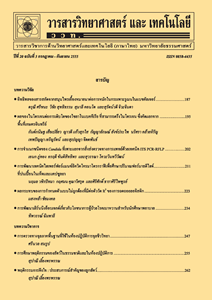ผลของ jasmonic acid และ yeast extract ต่อปริมาณสารทุติยภูมิของยอดหัวข้าวเย็น (Dioscorea birmanica Prain & Burkill) ในสภาพปลอดเชื้อ
Main Article Content
Abstract
บทคัดย่อ
หัวข้าวเย็น (Dioscorea birmanica Prain & Burkill) เป็นพืชสมุนไพรที่นิยมใช้ส่วนของเหง้าร่วมกับสมุนไพรชนิดอื่น ๆ ในการรักษาโรคมะเร็ง โรคน้ำเหลืองเสีย และเอดส์ ในการเพาะเลี้ยงเนื้อเยื่อพืชสามารถเติมสารกระตุ้น เช่น jasmonic acid (JA) และ yeast extract (YE) ลงในอาหารเพาะเลี้ยงเพื่อเพิ่มปริมาณสารทุติยภูมิ ดังนั้นในการทดลองนี้จึงมีวัตถุประสงค์เพื่อศึกษาผลของ JA และ YE ที่ความเข้มข้นต่าง ๆ ต่อปริมาณสารทุติยภูมิของหัวข้าวเย็นเมื่อเพาะเลี้ยงยอดในสภาพปลอดเชื้อ จากการทดลองพบว่ายอดที่พัฒนาบนอาหารสูตร MS ที่เติมผงถ่าน 0.01 % BA ความเข้มข้น 2 mg/l, IAA ความเข้มข้น 0.1 mg/l, น้ำมะพร้าว 20 %, YE ความเข้มข้น 3 และ 4 g/l มีปริมาณสารซาโปนินทั้งหมดสูงสุด 1254.76±72.06 และ 1182.86±56.45 µg diosgenin/g dry extract ตามลำดับ ปริมาณสารประกอบฟีนอลิกทั้งหมดมีค่าสูงสุดเมื่อยอดพัฒนาบนอาหารที่เติม JA ความเข้มข้น 50 และ 100 µM มีค่าเท่ากับ 78.21±3.06 และ 80.66±3.59 mg GAE/g dry extract ตามลำดับ แต่ไม่แตกต่างอย่างมีนัยสำคัญทางสถิติกับค่าดังกล่าวของยอดที่พัฒนาบนอาหารที่เติม YE ความเข้มข้น 4 g/l และไม่เติมสารกระตุ้น ส่วนยอดที่พัฒนาบนอาหารที่เติม JA ความเข้มข้น 50 และ 100 µM ให้ฤทธิ์ต้านอนุมูลอิสระ DPPH (EC50) ดีที่สุด โดยมีค่าเท่ากับ 17.94±0.46 และ 18.98±0.44 µg/ml ตามลำดับ
คำสำคัญ : หัวข้าวเย็น; ซาโปนิน; สารประกอบฟีนอลิก; สารทุติยภูมิ; สารกระตุ้น
Abstract
Hua-Khao-Yen (Dioscorea birmanica Prain & Burkill) is a medicinal plant which its rhizome has been used with other medicinal plant species for the treatments of cancers, lymphatic diseases and AIDS. Supplementation of elicitors such as jasmonic acid (JA) and yeast extract (YE) in culture medium has been used to stimulate secondary metabolite contents in plant tissue culture. Therefore, the objective of this study was to investigate the effects of JA and YE concentrations on secondary metabolite contents of Hua-Khao-Yen shoots grown under aseptic conditions. The results showed that the highest total saponin contents of 1254.76±72.06 and 1182.86±56.45 µg diosgenin/g dry extract respectively occurred on MS medium supplemented with 0.01 % activated charcoal, 2 mg/l BA, 0.1 mg/l IAA, 20 % coconut water in combination with 3 and 4 g/l YE. The highest total phenolic contents of 78.21±3.06 and 80.66±3.59 mg GAE/g dry extract were observed when shoots were cultured on medium supplemented with 50 and 100 µM JA respectively which were not significantly different with those culture on medium supplemented with 4 g/l YE or without elicitor. Shoots cultured on medium supplemented with 50 and 100 µM JA were also contained the greatest DPPH radical scavenging activity of 17.94±0.46 and 18.98±0.44 µg/ml respectively.
Keywords: Dioscorea birmanica; saponin; phenolic compound; secondary metabolite; elicitor

